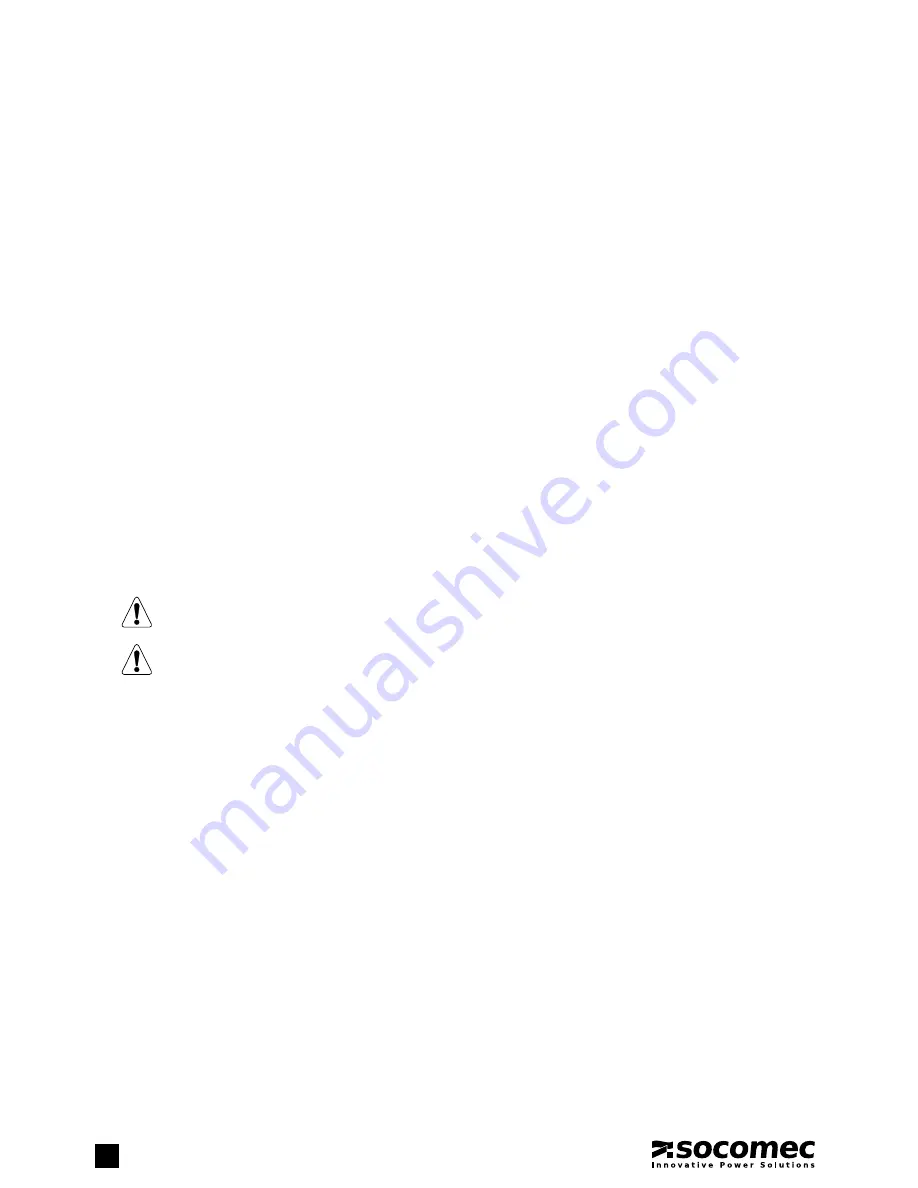
4
ITYS
1-10 kVA - Ref.: IOMITYTWXX05-GB 00
1. SAFETY STANDARDS
1.1. IMPORTANT
This manual should be kept in a safe place near the UPS, so it can be consulted by the operator at any time for information that
may be needed regarding correct use of the unit. Read the manual carefully before connecting the unit to the a.c. mains supply and
the downstream appliances. Before the UPS is put into commission the user should be completely familiar with its operation, the
position of all the controls and the technical and functional characteristics of the unit, so as to ensure there will be no risk to people
or the appliance itself.
• Before being started, the unit must be equipotentially bonded, in accordance with current safety regulations. The earth wire of the
UPS must then be connected to an efficient earth system.
• If there is no earth connection, the appliances connected to the UPS will not be equipotentially bonded. In this situation, the manu-
facturer declines all liability for any damage or accidents that could result from failure to observe the requirements.
• Should a power outage occur (UPS in stand-alone mode), do not disconnect the power cord from the mains, as this will break the
earth connection to bonded appliances.
• All subsequent maintenance operations must only be performed by authorised service engineers. The UPS generates high internal
voltages that could be hazardous for a maintenance operative not in possession of the appropriate skills and training for this type
of work.
• If a hazardous situation should arise at any time when the UPS is in use, isolate the unit from the power supply (by operating a
switch at the upstream PDU if possible) and switch the appliance off completely by running the shutdown procedure.
• The UPS houses a source of electrical energy, i.e. its batteries. The output of the UPS may be powered even when the appliance
is not connected to the a.c. mains supply.
• Never force, break or attempt to open the batteries. These batteries are sealed, maintenance-free components containing subs-
tances that are harmful to health and a source of environmental pollution. If liquid can be seen leaking from the battery, or a white
powdery residue is noticeable, do not switch the UPS on.
• Avoid exposing the UPS to contact with water or any liquids generally. Do not insert foreign objects into the cabinet.
• Danger of explosion if the batteries are replaced with others of the wrong type.
• Replaced batteries must be disposed of at authorised waste disposal centres.
It is very dangerous to touch any part of the batteries as there is no insulation between the batteries and the mains
power source.
CAUTION!
A battery can present a risk of electrical shock and high short circuit current.
• If the appliance is to be disposed of it should only be entrusted to a specialist waste disposal company. These companies will
dismantle and dispose of the various components in accordance with statutory regulations in the country of purchase.
• Use the UPS in accordance with the technical specifications indicated in this manual.
• To meet Emergency Switch Device (ESD) operating requirements, a specific input with remote ESD/EPO function is available.
• In the event that the equipment has no automatic backfeed protection contactor device, ensure that:
- the user/installer attaches warning labels to all mains isolating switches located remotely from the area where the UPS is situated,
in order to inform service personnel that the circuit is connected to a UPS.
- an external isolating device is installed
• The product you have selected, given the specified conditions of use, capacity and performance limits, is designed exclusively for
commercial and industrial operation. Using the product in critical applications could require compliance with statutory regulations
and standards, specific local bylaws, or adaptation to SOCOMEC recommendations. For this type of use it is always advisable to
contact SOCOMEC beforehand for confirmation regarding the capacity of products to meet required levels of safety, performance
and reliability. Critical applications include, in particular, life support systems, medical applications, commercial transport, nuclear
facilities or any other systems where failure of the product might on occasion cause serious damage to people or property.





































